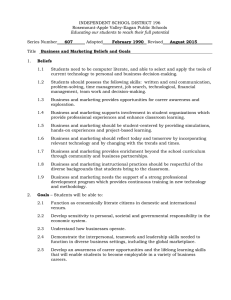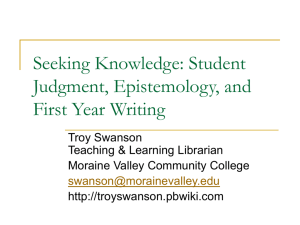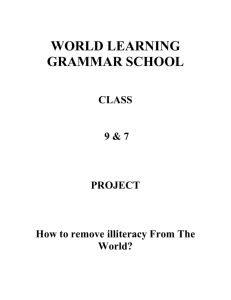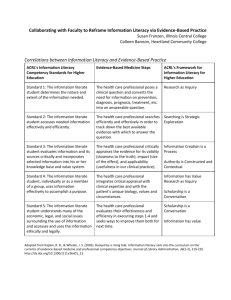Cleveland State University General Education Program Assessment Plan (Information Literacy)
advertisement
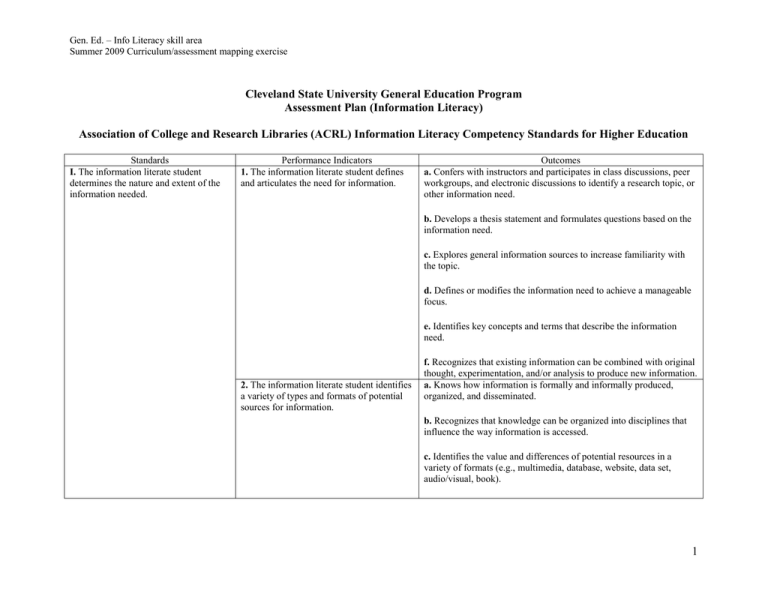
Gen. Ed. – Info Literacy skill area Summer 2009 Curriculum/assessment mapping exercise Cleveland State University General Education Program Assessment Plan (Information Literacy) Association of College and Research Libraries (ACRL) Information Literacy Competency Standards for Higher Education Standards I. The information literate student determines the nature and extent of the information needed. Performance Indicators 1. The information literate student defines and articulates the need for information. Outcomes a. Confers with instructors and participates in class discussions, peer workgroups, and electronic discussions to identify a research topic, or other information need. b. Develops a thesis statement and formulates questions based on the information need. c. Explores general information sources to increase familiarity with the topic. d. Defines or modifies the information need to achieve a manageable focus. e. Identifies key concepts and terms that describe the information need. 2. The information literate student identifies a variety of types and formats of potential sources for information. f. Recognizes that existing information can be combined with original thought, experimentation, and/or analysis to produce new information. a. Knows how information is formally and informally produced, organized, and disseminated. b. Recognizes that knowledge can be organized into disciplines that influence the way information is accessed. c. Identifies the value and differences of potential resources in a variety of formats (e.g., multimedia, database, website, data set, audio/visual, book). 1 Gen. Ed. – Info Literacy skill area Summer 2009 Curriculum/assessment mapping exercise d. Identifies the purpose and audience of potential resources (e.g., popular vs. scholarly, current vs. historical). e. Differentiates between primary and secondary sources, recognizing how their use and importance vary with each discipline. 3. The information literate student considers the costs and benefits of acquiring the needed information. f. Realizes that information may need to be constructed with raw data from primary sources. a. Determines the availability of needed information and makes decisions on broadening the information seeking process beyond local resources (e.g., interlibrary loan; using resources at other locations; obtaining images, videos, text, or sound). b. Considers the feasibility of acquiring a new language or skill (e.g., foreign or discipline-based) in order to gather needed information and to understand its context. 4. The information literate student reevaluates the nature and extent of the information need. II. The information literate student accesses needed information effectively and efficiently. 1. The information literate student selects the most appropriate investigative methods or information retrieval systems for accessing the needed information. c. Defines a realistic overall plan and timeline to acquire the needed information. a. Reviews the initial information need to clarify, revise, or refine the question. b. Describes criteria used to make information decisions and choices. a. Identifies appropriate investigative methods (e.g., laboratory experiment, simulation, fieldwork). b. Investigates benefits and applicability of various investigative methods. c. Investigates the scope, content, and organization of information retrieval systems. d. Selects efficient and effective approaches for accessing the information needed from the investigative method or information retrieval system. 2 Gen. Ed. – Info Literacy skill area Summer 2009 Curriculum/assessment mapping exercise 2. The information literate student constructs and implements effectivelydesigned search strategies. a. Develops a research plan appropriate to the investigative method. b. Identifies keywords, synonyms and related terms for the information needed. c. Selects controlled vocabulary specific to the discipline or information retrieval source. d. Constructs a search strategy using appropriate commands for the information retrieval system selected (e.g., Boolean operators, truncation, and proximity for search engines; internal organizers such as indexes for books). e. Implements the search strategy in various information retrieval systems using different user interfaces and search engines, with different command languages, protocols, and search parameters. 3. The information literate student retrieves information online or in person using a variety of methods. f. Implements the search using investigative protocols appropriate to the discipline. a. Uses various search systems to retrieve information in a variety of formats. b. Uses various classification schemes and other systems (e.g., call number systems or indexes) to locate information resources within the library or to identify specific sites for physical exploration. c. Uses specialized online or in person services available at the institution to retrieve information needed (e.g., interlibrary loan/document delivery, professional associations, institutional research offices, community resources, experts and practitioners). 4. The information literate student refines the search strategy if necessary. d. Uses surveys, letters, interviews, and other forms of inquiry to retrieve primary information. a. Assesses the quantity, quality, and relevance of the search results to determine whether alternative information retrieval systems or 3 Gen. Ed. – Info Literacy skill area Summer 2009 Curriculum/assessment mapping exercise investigative methods should be utilized. b. Identifies gaps in the information retrieved and determines if the search strategy should be revised. 5. The information literate student extracts, records, and manages the information and its sources. c. Repeats the search using the revised strategy as necessary. a. Selects among various technologies the most appropriate one for the task of extracting the needed information (e.g., copy/paste software functions, photocopier, scanner, audio/visual equipment, or exploratory instruments). b. Creates a system for organizing the information. c. Differentiates between the types of sources cited and understands the elements and correct syntax of a citation for a wide range of resources. d. Records all pertinent citation information for future reference. e. Uses various technologies to manage the information selected and organized. III. The information literate student evaluates information and its sources critically and incorporates selected information in his or her knowledge base and value system. 1. The information literate student summarizes the main ideas to be extracted from the information gathered. 2. The information literate student articulates and applies initial criteria for evaluating both the information and its sources. a. Reads the text and selects main ideas. b. Restates textual concepts in his/her own words and selects data accurately. c. Identifies verbatim material that can be then appropriately quoted. a. Examines and compares information from various sources in order to evaluate reliability, validity, accuracy, authority, timeliness, and point of view or bias. b. Analyzes the structure and logic of supporting arguments or methods. 4 Gen. Ed. – Info Literacy skill area Summer 2009 Curriculum/assessment mapping exercise c. Recognizes prejudice, deception, or manipulation. 3. The information literate student synthesizes main ideas to construct new concepts. d. Recognizes the cultural, physical, or other context within which the information was created and understands the impact of context on interpreting the information. a. Recognizes interrelationships among concepts and combines them into potentially useful primary statements with supporting evidence. b. Extends initial synthesis, when possible, at a higher level of abstraction to construct new hypotheses that may require additional information. 4. The information literate student compares new knowledge with prior knowledge to determine the value added, contradictions, or other unique characteristics of the information. c. Utilizes computer and other technologies (e.g. spreadsheets, databases, multimedia, and audio or visual equipment) for studying the interaction of ideas and other phenomena. a. Determines whether information satisfies the research or other information need. b. Uses consciously selected criteria to determine whether the information contradicts or verifies information used from other sources. c. Draws conclusions based upon information gathered. d. Tests theories with discipline-appropriate techniques (e.g., simulators, experiments). e. Determines probable accuracy by questioning the source of the data, the limitations of the information gathering tools or strategies, and the reasonableness of the conclusions. f. Integrates new information with previous information or knowledge. g. Selects information that provides evidence for the topic. 5 Gen. Ed. – Info Literacy skill area Summer 2009 Curriculum/assessment mapping exercise 5. The information literate student determines whether the new knowledge has an impact on the individual’s value system and takes steps to reconcile differences. 6. The information literate student validates understanding and interpretation of the information through discourse with other individuals, subject-area experts, and/or practitioners. 7. The information literate student determines whether the initial query should be revised. a. Investigates differing viewpoints encountered in the literature. b. Determines whether to incorporate or reject viewpoints encountered. a. Participates in classroom and other discussions. b. Participates in class-sponsored electronic communication forums designed to encourage discourse on the topic (e.g., email, bulletin boards, chat rooms). c. Seeks expert opinion through a variety of mechanisms (e.g., interviews, email, listservs). a. Determines if original information need has been satisfied or if additional information is needed. b. Reviews search strategy and incorporates additional concepts as necessary. c. Reviews information retrieval sources used and expands to include others as needed. IV. The information literate student, individually or as a member of a group, uses information effectively to accomplish a specific purpose. 1. The information literate student applies new and prior information to the planning and creation of a particular product or performance. a. Organizes the content in a manner that supports the purposes and format of the product or performance (e.g. outlines, drafts, storyboards). b. Articulates knowledge and skills transferred from prior experiences to planning and creating the product or performance. c. Integrates the new and prior information, including quotations and paraphrasings, in a manner that supports the purposes of the product or performance. d. Manipulates digital text, images, and data, as needed, transferring them from their original locations and formats to a new context. 6 Gen. Ed. – Info Literacy skill area Summer 2009 Curriculum/assessment mapping exercise 2. The information literate student revises the development process for the product or performance. 3. The information literate student communicates the product or performance effectively to others. a. Maintains a journal or log of activities related to the information seeking, evaluating, and communicating process. b. Reflects on past successes, failures, and alternative strategies. a. Chooses a communication medium and format that best supports the purposes of the product or performance and the intended audience. b. Uses a range of information technology applications in creating the product or performance. c. Incorporates principles of design and communication. d. Communicates clearly and with a style that supports the purposes of the intended audience. V. The information literate student understands many of the economic, legal, and social issues surrounding the use of information and accesses and uses information ethically and legally. 1. The information literate student understands many of the ethical, legal and socio-economic issues surrounding information and information technology. a. Identifies and discusses issues related to privacy and security in both the print and electronic environments. b. Identifies and discusses issues related to free vs. fee-based access to information. c. Identifies and discusses issues related to censorship and freedom of speech. 2. The information literate student follows laws, regulations, institutional policies, and etiquette related to the access and use of information resources. d. Demonstrates an understanding of intellectual property, copyright, and fair use of copyrighted material. a. Participates in electronic discussions following accepted practices (e.g. "Netiquette"). b. Uses approved passwords and other forms of ID for access to information resources. c. Complies with institutional policies on access to information resources. 7 Gen. Ed. – Info Literacy skill area Summer 2009 Curriculum/assessment mapping exercise d. Preserves the integrity of information resources, equipment, systems and facilities. e. Legally obtains, stores, and disseminates text, data, images, or sounds. f. Demonstrates an understanding of what constitutes plagiarism and does not represent work attributable to others as his/her own. 3. The information literate student acknowledges the use of information sources in communicating the product or performance. g. Demonstrates an understanding of institutional policies related to human subjects research. a. Selects an appropriate documentation style and uses it consistently to cite sources. b. Posts permission granted notices, as needed, for copyrighted material. (Available at http://www.acrl.org/ala/mgrps/divs/acrl/standards/informationliteracycompetency.cfm) 8
